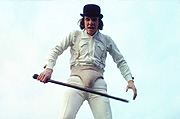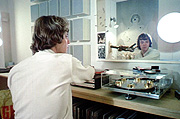[Original works from the Stanley Kubrick Estate.
Stanley Kubrick and Geoffrey Unsworth developed a system for calculating from the grey tones of b/w Polaroids the right lighting for filming
2001: A SPACE ODYSSEY.]
Update
¬ Subscribe Newsletter
Newsletter No. 3, January 2004
Dear Colleagues and Friends,
Stanley Kubrick was a director who was exceptionally visual in his approach to film and
for whom the motif of the (wide open) eye has become something of an icon. Kubrick's
roots were in photography and his innovations in the field of camera technology and
special effects have long since become legend. In fact, you could almost say that no
one has been quite as refined in staging what appears before the camera. The very first
worldwide exhibition on his oeuvre will take place in the form of "interdisciplinary"
collaboration between Deutsches Filmmuseum and Deutsches Architektur Museum (DAM), and
this amply demonstrates that there is more at stake here than simply honoring a filmmaker.
Indeed, the show will likewise highlight Kubrick's visionary adaptation of influences from
the applied arts, design and architecture and will offer the chance to experience the cosmos
of a great 20th century artist whose impact is so great it appears almost explosive on screen.
For all the emphatic foregrounding of visual elements in Kubrick's work, sound design and in
particular music were also uniquely important in his work. Accordingly, the multimedia thrust
of the exhibition will make certain there is not only a host of visual experiences but also
aural experiences –we would like to briefly familiarize you here with these aural sculptures.
This newsletter focuses on one of Kubrick's most controversial films: A CLOCKWORK ORANGE, a
brilliant reflection on the impact of images in which music also plays a decisive role.
1. Work in progress
The exhibition will be shown on three floors: The ground floor of the Filmmuseum and the
ground and first floors of the DAM. On the upper floor we will be presenting two of Kubrick's
films which have had the most lasting impact, namely 2001: A SPACE ODYSSEY and A CLOCKWORK ORANGE.
There is space here for juxtaposing architectural designs from the period in which the films were
made and presenting original design objects such as Oliver Mourgue’s "Djinn" chair, Hamilton's clock
and Arne Jacobsen's tableware. Kubrick always researched his sets down to the finest details.
For A CLOCKWORK ORANGE he scrutinized volumes of design and architecture magazines and projected
an exaggerated version of the Pop Art aesthetic of the 1970s into the future.

On show will be not just original and reproduced props such as the dolls inspired by Allen
Jones from the Korova Milkbar but also the Droog costume worn by Alex (Malcolm McDowell)
including his bowler hat and sword cane; the white jacket and white trousers with braces
and codpiece will be replicated by Theaterkunst, Berlin. The original costume was designed
by the Italian Milena Canonero, who went on to work on BARRY LYNDON and THE SHINING. In an
essay for the exhibition catalogue entitled "Masks of Violence", author Marisa Buovolo
offers a precise analysis of the multi-level language of Canonero’s costumes in A CLOCKWORK ORANGE.
Malcolm McDowell, the leading actor in A CLOCKWORK ORANGE, plays a very special role in the
exhibition: his voice will guide international visitors through the two museums. In cooperation
with Linon Medien a bilingual audio guide is being produced, which is not just an additional
offering, but forms an integral part of the presentation. The audioguide will thus introduce
the films, comment on the individual exhibits, and present aural documents and musical passages
from the film. The German part is spoken by actor Jörg Pleva, who also did the dubbing for
Malcolm McDowell as Alex (and subsequently for two more Kubrick protagonists: Ryan O'Neal alias
BARRY LYNDON and Jack Nicholson alias Jack Torrance in THE SHINING).
The DAM will also house a special room on Kubrick's film music located on the upper floor. The
forms of Kubrick's use of music will be explained in a black box with the help of an audiovisual
presentation. This presentation is the brainchild of composer Bernd Schultheis, who also addresses
this theme in the exhibition catalogue.
2. This Month’s object

Alex de Large is obsessed with music – especially one sort: "Ludwig Van". At one point you see
him in a dandy outfit wandering through a colorful record shop in which Kubrick coquettishly
placed the soundtrack of 2001: A SPACE ODYSSEY. At home he puts on a small tape with the 9th
Symphony; part of his futuristic room interior, however, features a very special record player
which shows up again at the end of the film (when Alex is taken under the wings of the authorities
and lying in his hospital bed is surprised with flowers and Beethoven music when the Home Minister
visits). The "Hydraulic Reference" turntable was developed in 1964 by David Gammon, who received
the London Design Center Prize for it in 1971. One of them is in the possession of the Museum of
Modern Art, New York. The model was marketed by
Transcriptors and later by John Michell (who also
designed a number of spaceship models for 2001: A SPACE ODYSSEY). In the period when he was
preparing for A CLOCKWORK ORANGE, Kubrick visited David Gammon in his factory in Borehamwood
and was given a "Hydraulic Reference". His son, Michael Gammon, is so kind to contribute an
identical one to the exhibition.
3. Short portrait
The unmistakable soundtrack of A CLOCKWORK ORANGE was created by
¬ Wendy Carlos – a pioneer in electronic music. Born in 1939 she mastered the spinet at age six; on
completing her schooling she started studying physics at Rhode Island but then changed her
major to music. The combination of these two disciplines made it obvious that she went on to
experiment with synthetic sounds. In 1963, she met Robert Moog who invented the analogue
synthesizer. Together they developed the "Moog III" on which Wendy Carlos played her epoch-making piece
Switched on Bach, the very first completely electronic adaptation of classical music. Subsequent
records of hers included
The Well-Tempered Synthesizer, and
A Clockwork Orange; she also composed
music for Kubrick's THE SHINING.
More information on Wendy Carlos:
¬ www.wendycarlos.com
4. Miscellaneous
During the 54th Berlin International Film Festival on February 9, Deutsches Filmmuseum and
Deutsches Architektur Museum will hold a reception at the State of Hesse Representative
Office in Berlin. The exhibition will be presented there to officially invited guests in
the presence of Jan Harlan and Minister Udo Corts (Hesse Ministery for Science and Art).
This month’s website:
¬ www.malcolmmcdowell.net. On the actor's homepage almost everything
centers around A CLOCKWORK ORANGE. In addition to a description how to make an Alex costume,
and a Nadsat dictionary, the site offers numerous other navigation items relating to the film,
such as "Articles", "Book History", "Media Mentions", "Pop Culture", "Props" and "X- versus
R-rated Versions". Some sections are devoted to Stanley Kubrick's overall oeuvre – as well as
texts and interviews there is also a small overview of Kubrick quotes and parodies in films and
TV series, above all, needless to say,
The Simpsons.
¬ print


 On show will be not just original and reproduced props such as the dolls inspired by Allen
Jones from the Korova Milkbar but also the Droog costume worn by Alex (Malcolm McDowell)
including his bowler hat and sword cane; the white jacket and white trousers with braces
and codpiece will be replicated by Theaterkunst, Berlin. The original costume was designed
by the Italian Milena Canonero, who went on to work on BARRY LYNDON and THE SHINING. In an
essay for the exhibition catalogue entitled "Masks of Violence", author Marisa Buovolo
offers a precise analysis of the multi-level language of Canonero’s costumes in A CLOCKWORK ORANGE.
On show will be not just original and reproduced props such as the dolls inspired by Allen
Jones from the Korova Milkbar but also the Droog costume worn by Alex (Malcolm McDowell)
including his bowler hat and sword cane; the white jacket and white trousers with braces
and codpiece will be replicated by Theaterkunst, Berlin. The original costume was designed
by the Italian Milena Canonero, who went on to work on BARRY LYNDON and THE SHINING. In an
essay for the exhibition catalogue entitled "Masks of Violence", author Marisa Buovolo
offers a precise analysis of the multi-level language of Canonero’s costumes in A CLOCKWORK ORANGE.  Alex de Large is obsessed with music – especially one sort: "Ludwig Van". At one point you see
him in a dandy outfit wandering through a colorful record shop in which Kubrick coquettishly
placed the soundtrack of 2001: A SPACE ODYSSEY. At home he puts on a small tape with the 9th
Symphony; part of his futuristic room interior, however, features a very special record player
which shows up again at the end of the film (when Alex is taken under the wings of the authorities
and lying in his hospital bed is surprised with flowers and Beethoven music when the Home Minister
visits). The "Hydraulic Reference" turntable was developed in 1964 by David Gammon, who received
the London Design Center Prize for it in 1971. One of them is in the possession of the Museum of
Modern Art, New York. The model was marketed by Transcriptors and later by John Michell (who also
designed a number of spaceship models for 2001: A SPACE ODYSSEY). In the period when he was
preparing for A CLOCKWORK ORANGE, Kubrick visited David Gammon in his factory in Borehamwood
and was given a "Hydraulic Reference". His son, Michael Gammon, is so kind to contribute an
identical one to the exhibition.
Alex de Large is obsessed with music – especially one sort: "Ludwig Van". At one point you see
him in a dandy outfit wandering through a colorful record shop in which Kubrick coquettishly
placed the soundtrack of 2001: A SPACE ODYSSEY. At home he puts on a small tape with the 9th
Symphony; part of his futuristic room interior, however, features a very special record player
which shows up again at the end of the film (when Alex is taken under the wings of the authorities
and lying in his hospital bed is surprised with flowers and Beethoven music when the Home Minister
visits). The "Hydraulic Reference" turntable was developed in 1964 by David Gammon, who received
the London Design Center Prize for it in 1971. One of them is in the possession of the Museum of
Modern Art, New York. The model was marketed by Transcriptors and later by John Michell (who also
designed a number of spaceship models for 2001: A SPACE ODYSSEY). In the period when he was
preparing for A CLOCKWORK ORANGE, Kubrick visited David Gammon in his factory in Borehamwood
and was given a "Hydraulic Reference". His son, Michael Gammon, is so kind to contribute an
identical one to the exhibition.